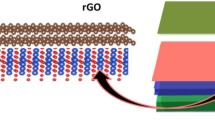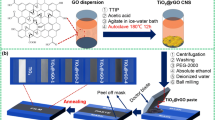Abstract
In this study, graphene–TiO2 nanostructures and CuO nanorods were produced on FTO (F:SnO2) substrates using the cost effective hydrothermal growth method. The interface effects of the graphene–TiO2 nanostructures were examined to compare with pure TiO2 photoanode in respect to solar cell efficiency. Graphene–TiO2 was shown as a perfect alternative for the standard F:SnO2 (FTO)/TiO2 working electrodes in dye-sensitized solar cells due to its higher electro-optic activity, surface area and good charge transport characteristics. Furthermore, CuO nanorods were also investigated as efficient counter electrodes (CEs) to be used in place of the conventional and costly platinum (Pt) CEs. By utilizing graphene–TiO2 photoanode and CuO nanorod based CEs, hybrid solar cells with photovoltaic efficiency of 6.18% under AM 1.5G solar radiation were produced. According to the external quantum efficiency (EQE) of the hybrid solar cell agreement with the J–V measurements, the device based on the hybrid CuO CE exhibited higher EQE. EQE was improved by 30% compared to the Pt CE due to the higher Jsc, Voc and the fill factor of the hybrid devices.





Similar content being viewed by others
References
Anandan, S., Wen, X., Yang, S.: Room temperature growth of CuO nanorod arrays on copper and their application as a cathode in dye-sensitized solar cells. Mater. Chem. Phys. 93(1), 35–40 (2005a)
Anandan, S., Wen, X., Yang, S.: Room temperature growth of CuO nanorod arrays on copper and their application as a cathode in dye-sensitized solar cells. Mater. Chem. Phys. 93, 35–40 (2005b)
Chung, I., Lee, B., He, J., Chang, R.P., Kanatzidis, M.G.: All-solid-state dye-sensitized solar cells with high efficiency. Nature 485(7399), 486–489 (2012)
Dao, V.D., Larina, L.L., Suh, H., Hong, K., Lee, J.K., Choi, H.S.: Optimum strategy for designing a graphene-based counter electrode for dye-sensitized solar cells. Carbon 1(77), 980–992 (2014)
Dao, V.D., Larina, L.L., Tran, Q.C., Bui, V.T., Nguyen, V.T., Pham, T.D., Choi, H.S.: Evaluation of Pt-based alloy/graphene nanohybrid electrocatalysts for triiodide reduction in photovoltaics. Carbon 116, 294–302 (2017)
Favereau, L., Warnan, J., Pellegrin, Y., Blart, E., Boujtita, M., Jacquemin, D., Odobel, F.: Diketopyrrolopyrrole derivatives for efficient NiO-based dye-sensitized solar cells. Chem. Commun. 49(73), 8018–8020 (2013)
Feng, X., Shankar, K., Varghese, O.K., Paulose, M., Latempa, T.J., Grimes, C.A.: Vertically aligned single crystal TiO2 nanowire arrays grown directly on transparent conducting oxide coated glass: synthesis details and applications. Nano Lett. 8(11), 3781–3786 (2008)
Golobostanfard, M.R., Abdizadeh, H.: Hierarchical porous titania/carbon nanotube nanocomposite photoanode synthesized by controlled phase separation for dye sensitized solar cell. Sol. Energy Mater. Sol. Cells 31(120), 295–302 (2014)
Grätzel, M.: Dye-sensitized solar cells. J. Photochem. Photobiol. C 4(2), 145–153 (2003)
Hagfeldt, A., Boschloo, G., Sun, L., Kloo, L., Pettersson, H.: Dye-sensitized solar cells. Chem. Rev. 110(11), 6595–6663 (2010)
Kakiage, K., Aoyama, Y., Yano, T., Oya, K., Fujisawa, J.I., Hanaya, M.: Highly-efficient dye-sensitized solar cells with collaborative sensitization by silyl-anchor and carboxy-anchor dyes. Chem. Commun. 51(88), 15894–15897 (2015)
Le Pleux, L., Smeigh, A.L., Gibson, E., Pellegrin, Y., Blart, E., Boschloo, G., Hagfeldt, A., Hammarström, L., Odobel, F.: Synthesis, photophysical and photovoltaic investigations of acceptor-functionalized perylene monoimide dyes for nickel oxide p-type dye-sensitized solar cells. Energy Environ. Sci. 4(6), 2075–2084 (2011)
Liu, Y., Liao, L., Li, J., Pan, C.: From copper nanocrystalline to CuO nanoneedle array: synthesis, growth mechanism, and properties. J. Phys. Chem. C 111, 5050–5056 (2007)
Mathew, S., Yella, A., Gao, P., Humphry-Baker, R., Curchod, B.F., Ashari-Astani, N., Tavernelli, I., Rothlisberger, U., Nazeeruddin, M.K., Grätzel, M.: Dye-sensitized solar cells with 13% efficiency achieved through the molecular engineering of porphyrin sensitizers. Nat. Chem. 6(3), 242–247 (2014)
Morandeira, A., Boschloo, G., Hagfeldt, A., Hammarstrom, L.: Coumarin 343—NiO films as nanostructured photocathodes in dye-sensitized solar cells: ultrafast electron transfer, effect of the I3−/I− redox couple and mechanism of photocurrent generation. J. Phys. Chem. C 112(25), 9530–9537 (2008)
O’regan, B., Grätzel, M.: A low-cost, high-efficiency solar cell based on dye-sensitized colloidal TiO2 films. Nature 353(6346), 737–740 (1991)
Odobel, F., Pellegrin, Y.: Recent advances in the sensitization of wide-band-gap nanostructured p-type semiconductors. Photovoltaic and photocatalytic applications. J. Phys. Chem. Lett. 4(15), 2551–2564 (2013)
Oh, H.J., Dao, V.D., Choi, H.S.: Cost-effective CoPd alloy/reduced graphene oxide counter electrodes as a new avenue for high-efficiency liquid junction photovoltaic devices. J. Alloys Compd. 705, 610–617 (2017)
Park, E., Lee, Y., Dao, V.D., Cam, N.T.D., Choi, H.S.: Design of CoNi alloy/graphene as an efficient Pt-free counter electrode in liquid junction photovoltaic devices. Synth. Met. 230, 97–104 (2017)
Poudel, P., Qiao, Q.: Carbon nanostructure counter electrodes for low cost and stable dye-sensitized solar cells. Nano Energy 31(4), 157–175 (2014)
Qin, P., Wiberg, J., Gibson, E.A., Linder, M., Li, L., Brinck, T., Hagfeldt, A., Albinsson, B., Sun, L.: Synthesis and mechanistic studies of organic chromophores with different energy levels for p-type dye-sensitized solar cells. J. Phys. Chem. C 114(10), 4738–4748 (2010)
Sharma, J.K., Akhtar, M.S., Ameen, S., Srivastava, P., Singh, G.: Green synthesis of CuO nanoparticles with leaf extract of Calotropis gigantea and its dye-sensitized solar cells applications. J. Alloys Compd. 632, 321–325 (2015)
Sim, E., Dao, V.D., Choi, H.S.: Pt-free counter electrode based on FeNi alloy/reduced graphene oxide in liquid junction photovoltaic devices. J. Alloys Compd. 742, 334–341 (2018)
Tsai, C.H., Fei, P.H., Lin, C.M., Shiu, S.L.: CuO and CuO/graphene nanostructured thin films as counter electrodes for Pt-free dye-sensitized solar cells. Coatings 8(1), 21 (2018)
Wang, X., Zhi, L., Müllen, K.: Transparent, conductive graphene electrodes for dye-sensitized solar cells. Nano Lett. 8(1), 323–327 (2008)
Wood, C.J., Cheng, M., Clark, C.A., Horvath, R., Clark, I.P., Hamilton, M.L., Towrie, M., George, M.W., Sun, L., Yang, X., Gibson, E.A.: Red-absorbing cationic acceptor dyes for photocathodes in tandem solar cells. J. Phys. Chem. C 118(30), 16536–16546 (2014)
Zhang, Q., Cao, G.: Hierarchically structured photoelectrodes for dye-sensitized solar cells. J. Mater. Chem. 21(19), 6769–6774 (2011)
Author information
Authors and Affiliations
Corresponding author
Additional information
Publisher's Note
Springer Nature remains neutral with regard to jurisdictional claims in published maps and institutional affiliations.
Electronic supplementary material
Below is the link to the electronic supplementary material.
Rights and permissions
About this article
Cite this article
Kılıç, B. Interface effect of graphene–TiO2 photoanode with CuO nanorod counter electrode on solar conversion efficiency and enhanced external quantum efficiency. Opt Quant Electron 51, 208 (2019). https://doi.org/10.1007/s11082-019-1928-3
Received:
Accepted:
Published:
DOI: https://doi.org/10.1007/s11082-019-1928-3




